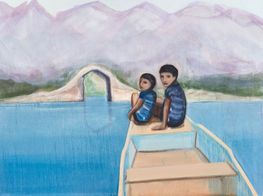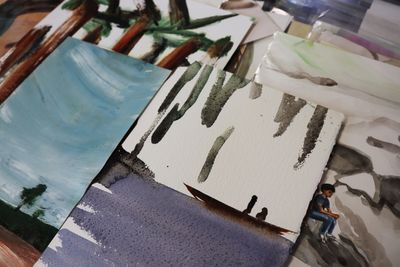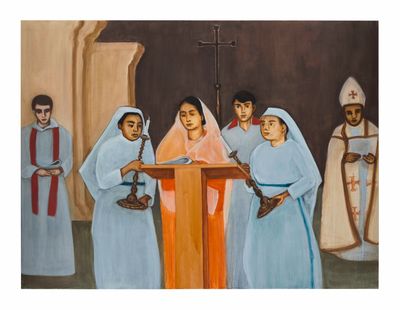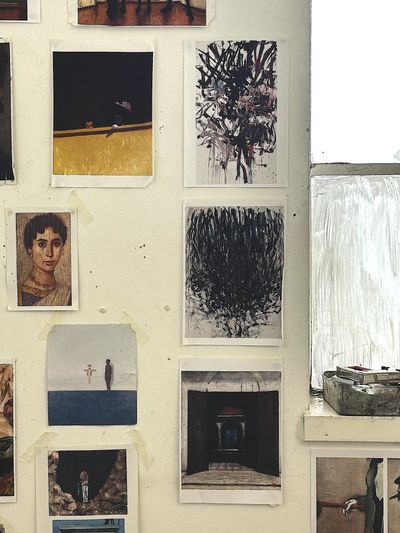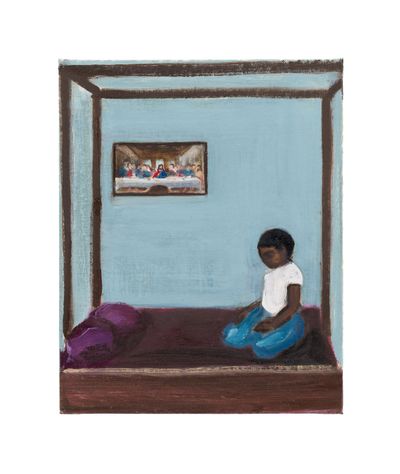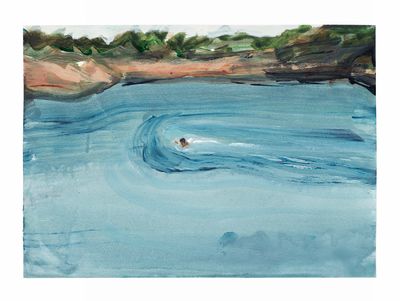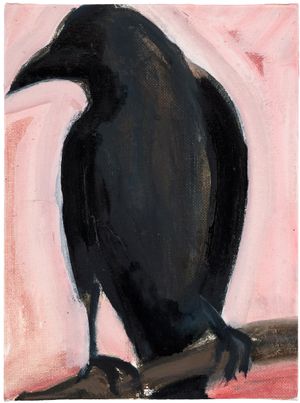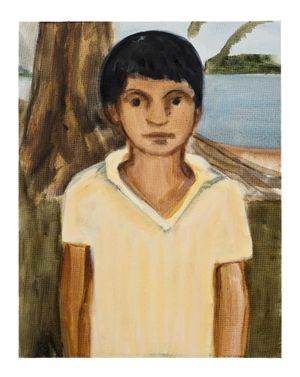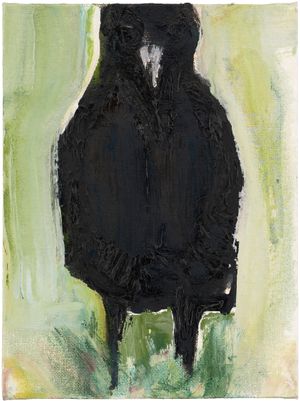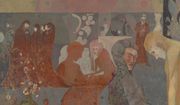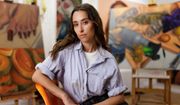
Matthew Krishanu in the Studio
Two young boys cling onto the limbs of a spindly banyan tree. A woman dressed in a sari sits on a sofa below a painting of Christ. A congregation of church-goers face a Christian priest in the Church of Bangladesh. Many of these moments were experienced during London-based painter Matthew Krishanu's upbringing in South Asia, and then re-experienced through his quiet and economical brush.
At Camden Art Centre, Krishanu's solo exhibition, The Bough Breaks (26 April–23 June 2024), follows a string of remarkable painting shows at the London institution by artists such as Martin Wong, Mohammed Sami, and Allison Katz.
Ahead of the exhibition, Ocula Advisory visited Krishanu's East London studio to discuss his latest paintings and drawings, the Joan Mitchell tree paintings pinned to his studio wall, and how he measures his own paintings' success.
Can you introduce the exhibition?
Titled The Bough Breaks, the exhibition centres on the idea of being out on a limb. Gallery One introduces this theme with two ongoing painting series: 'Another Country' and 'Other Places' exploring my childhood in India, Bangladesh, and Yorkshire, England, where I was born.
Several paintings in the series feature banyan trees, a plant that is native to areas close to the equator, especially in South Asia. They have amazing trunks with vines that grow from them, reroute in the ground, and then grow again. My brother and I used to climb in these trees when we were children, so paintings such as Banyan (Boy) (2023) and Banyan (Girl) (2024) serve this memory.
Gallery Two showcases my series 'Holy Family' and my 'Mission' series. The latter series includes portraits of my father as a Christian priest in the Church of Bangladesh, Bengali Christian bishops, and my mother, an academic and theology teacher.
We're going to have many works on paper, framed and unframed at different scales. These are the show's heartbeat, as my handling of paint and painterly themes have developed partly through 15 years of working on paper.
How do you prepare the canvases?
My paintings often start with a thin wash of acrylic paint, which I love as you achieve that airy, watery look. While part of the painting will almost be to the white of the primed canvas beneath, other parts, such as the back of a head or the bark of a tree, will have thick swathes of oil paint creating a dialogue between the oil, the surface of the acrylic and that of the canvas.
I map out the figures with a brush carrying very diluted paint. My aim is to give each figure a sense of interior life without becoming portraits of individual people.
Is there something about this more quiet, economical style that you reserve for religious subject matter?
For me, if I applied dense paint, my work would more directly relate to the history of Renaissance or Baroque painting—like the bulge of paint at the end of a nose in a Rembrandt. However, I don't have a desire to emulate this.
In contrast, using thin layers of paint and simplifying forms is closer to the language of contemporary painting—people like Hurvin Anderson, Peter Doig, or Mamma Andersson.
This economical style also speaks to geography and how these paintings relate to images I have pinned up around my studio: the Buddhist temple paintings in the Ajanta Caves in India, for instance, where we see really beautiful pared-back thin washes of paint. While this means they haven't survived particularly well, the fragility that comes into a lightly sketched face becomes a key part of how we read these works.
Postcards and printouts of other artists' paintings cover your studio walls. Can you talk us through a few?
Art history continually gives me ideas in terms of what I want to paint and how.
I keep going back to two wonderful Joan Mitchell paintings, Red Tree (1976) and Tilleul (1978), which are currently at Tate Modern on loan from Fondation Louis Vuitton. These abstract paintings were born out of Mitchell's observation of trees—their spindly branches and light filtering through the leaves—and were a constant influence when producing my large scale 'Banyan' paintings. Those and Soutine's incredible tree paintings.
Then we've got Munch's paintings of children and scenes of sickness and grieving or El Greco's Christ on the Cross Adored by Two Donors (c.1590), which feed conceptually and formally into how I handle paint.
Craigie Aitchison painted crucifixions with varied skin colour has influenced 'Mission'—my series exploring the role of Christian missionaries in India and Bangladesh.
You also have an enormous array of brushes.
I'll use perhaps 30 or 40 brushes in a day; I may make a few marks with one brush and then, particularly when painting in oil paint, will use another to achieve that freshness.
I occasionally paint with two brushes at once, particularly when working on the large 'Banyan' series as it allows me to enter the vast scale. As I paint thinly and quickly over many layers, I lay out all my paints across my palette, and always in the same order so my hands can move to the paints automatically. I spread my brushes out across the floor, starting with the wider brushes, to flat, filbert, and then round.
Are you good at knowing when to put the paintbrush down?
The point at which to stop working on a painting is hard-earned. In the early days, when I was developing my painterly language, I would sometimes feel myself killing paintings. On these occasions, you would almost grieve for a painting that you can't go back to. You can go on, but it's never quite the same.
Are there paintings that you can go back to?
I started Bedroom (Last Supper) (2023) a number of years ago, but it always felt unresolved. Returning to it last year, I realised that it just needed a few tonal changes and detail on the four poster bed and the Last Supper painting on the wall. Now it's one of my favourite paintings in the show.
Do you know all the figures you paint?
The boys are me and my brother. The girl could stand in for my daughter or one of my cousins as a child. But essentially the brown child scrambling up the tree within that equatorial landscape acts as a stand-in for viewers to project places or people that they've known, while also having that emotional connection.
Wilhelm Sasnal is a painter you look to. He's spoken about how he finds it hard to paint the people that are closest to him, such as his wife and son, and when he does, he always keeps back a part of them for himself. Do you find it hard painting your late wife or brother?
Sasnal's painting of his wife, Anka, smoking is so iconic. It's quintessentially Sasnal. I think often the best work comes through when you paint a subject you care about. For me, painting my late wife, brother, or indeed daughter, is about sensing a recognition for them through the paint. If it's not there, the painting isn't successful. It's really about what activates the painting, and painting people I know and care about is what makes me want to get to the end.
The two paintings of your late wife and daughter are particularly poignant.
They capture our last visit together to Epping Forest in Chingford, London, before my wife underwent treatment for cancer. It was a place that we deeply loved.
Mother and Child, (Tree, Epping Forest) (2024) depicts my daughter in a tree. Showing the painting as well as Sculpture Park (Two Boys) (2024), depicting my brother and me climbing a Henry Moore sculpture in Yorkshire Sculpture Park, is really about weaving together these different lives and childhoods.
They're paintings that, if somebody asked me to, I couldn't do again. They would have to be completely new—you find your way through it. —[O]
Main image: Matthew Krishanu. Photo: © Florrie Munro.
Selected Artworks
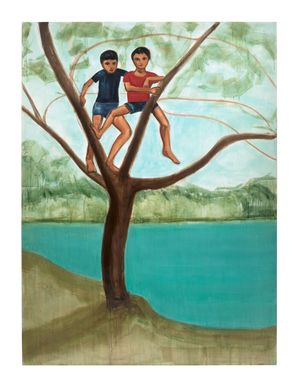
270 x 200 cm
Sold Jhaveri Contemporary

